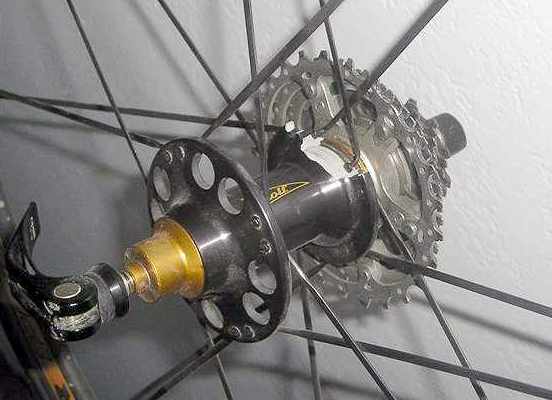
Top: John S. Allen's home page
Up: Expert witness
A HUB FAILURE© 2001-2003, John S. Allen The hub shown below failed with an audible "crack!" while the bicycle was simply hanging on the owner's wall. Why? |
Rolf wheel hub that failed

| On a conventional bicycle wheel with 28 or more evenly-spaced spokes, adjacent spokes
pull alternately toward and away from each other, canceling out the forces their tension
exerts on the hub flange. With individual spokes under 200 pounds or more of tension,
these forces are substantial. But the 16 spokes of this Rolf wheel were attached to the hub in pairs -- so that each flange had four quadrants pulling apart from each other. If the spokes closest to each other had been pulling toward each other instead, the part of the flange between them would have been in compression and the spokes would have placed little loading on the rest of the hub flange. However, all of the spokes are laced on the same side of each flange of this hub, in order to reduce the dishing of the wheel and more nearly equalize spoke tension on the two sides of the wheel. (Dishing is the reduced angle of the right-side spokes away from the rim's centerline, to make room for the sprockets. Dishing requires that the right-side spokes be more highly tensioned than the left-side spokes.) Spokes laced to the same side of the flange and pulling toward each other would have interfered with each other . The only 16 spokes had to be tensioned very highly to support the rider's weight. The hub flange is of an aluminum alloy, a material which develops tiny "fatigue" cracks when subjected to repeated cycles of increasing and decreasing tension, as in a bicycle wheel rotating under load. The cracks expand with continued use. This hub flange cracked between two of the spokes which pulled away from each other. Clearly, this wheel was designed based on engineering assumptions which did not properly take into account the characteristics of the aluminum of the hub shell. The owner of the wheel describes additional incipient failures:
Trek eventually did do something -- it discontinued sourcing wheels from Rolf, though Trek's explanation mentioned a supply issue and said nothing about reliability. Also, Rolf wheels have been redesigned; rear wheels now typically have 20 spokes. The wheels I use, though, all have 36 or more spokes. All the extra spokes slicing through the air may slow me down by a couple of percent, but I'm not a racer, so I don't care!
|
| Top: John S. Allen's home
page Up: Expert witness |
Contents © 2006, John S. Allen |